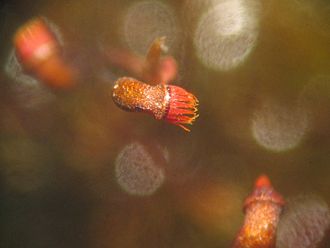Difference between revisions of "AY Honors/Lichens, Liverworts & Mosses/Answer Key/es"
(Created page with "</noinclude> <!-- 3. Nombrar por lo menos dos maneras de cómo los líquenes han sido de valor para el hombre. -->") |
(Created page with "</noinclude> <!-- 4. ¿Cómo se diferencian las hepáticas a todas las demás plantas verdes? Mencionar uno que se utiliza en acuarios. ¿Cuál es su función? -->") |
||
| Line 57: | Line 57: | ||
{{ansreq|page={{#titleparts:{{PAGENAME}}|2|1}}|num=4}} | {{ansreq|page={{#titleparts:{{PAGENAME}}|2|1}}|num=4}} | ||
<noinclude></noinclude> | <noinclude></noinclude> | ||
| − | <!-- 4. | + | <!-- 4. ¿Cómo se diferencian las hepáticas a todas las demás plantas verdes? Mencionar uno que se utiliza en acuarios. ¿Cuál es su función? --> |
| − | |||
{{clear}} | {{clear}} | ||
Revision as of 21:57, 25 February 2021
| Líquenes, hepáticas y musgos | ||
|---|---|---|
| Asociación General
|
Destreza: 3 Año de introducción: 1961 |
|
Requisitos
| Conexión Logros para la Investidura: Esta especialidad está relacionada con los requisitos de Logros para la Investidura para ORIENTADOR Estudio de la naturaleza que requiere (como una de dos opciones) completar un proyecto que es igual al requisito #6 de esta especialidad. |
1
2
3
4
5
Agriculture
Peat (Sphagnum moss) is used to loosen and fertilize soil for agriculture. It is also used in the construction material Peatcrete, and it has been used as fuel.
Landscaping
Moss is used as a base layer in the art of bonsai. It is also a popular terrarium plant.
Medicine
Moss was used for dressing wounds during World War I. It was also used as pillow filler for soldiers to rest upon when they were transported from the battlefield to the hospital.
Wallpaper
Sphagnum moss was used as wallpaper in the early 1900's.
6
Note: This activity meets a requirement in the Ranger AY Nature Study curriculum.
A terrarium may be constructed from any clear container of nearly any size, from baby food jars to storage tubs.
Start by putting down a layer of gravel, rocks, vermiculite or Perlite. Then place a layer of soil on top of this. Place the plants atop the soil and add a few rocks for interest. Water once, but do not overwater. Put the lid on and place the container in a place where it can receive indirect sunlight. If algae begins to grow on the container walls, move to a more shady location. You should not need to open the lid for months, as the terrarium will develop its own climate, and all the moisture remains in the container.
7
There are thousands of species of lichens, liverworts, and mosses, and providing an identification guide is well beyond the scope of this chapter. In order to meet this requirement, you will most likely need to obtain a field guide. Here are a few possibilities:
8
References
- Categoría: Tiene imagen de insignia
- Adventist Youth Honors Answer Book/Honors/es
- Adventist Youth Honors Answer Book/es
- Adventist Youth Honors Answer Book/Skill Level 3/es
- Categoría: Libro de respuestas de especialidades JA/Especialidades introducidas en 1961
- Adventist Youth Honors Answer Book/General Conference/es
- Adventist Youth Honors Answer Book/Nature/es
- Adventist Youth Honors Answer Book/Nature/Primary/es
- Adventist Youth Honors Answer Book/Stage 0/es
- Adventist Youth Honors Answer Book/IAConnection/es



